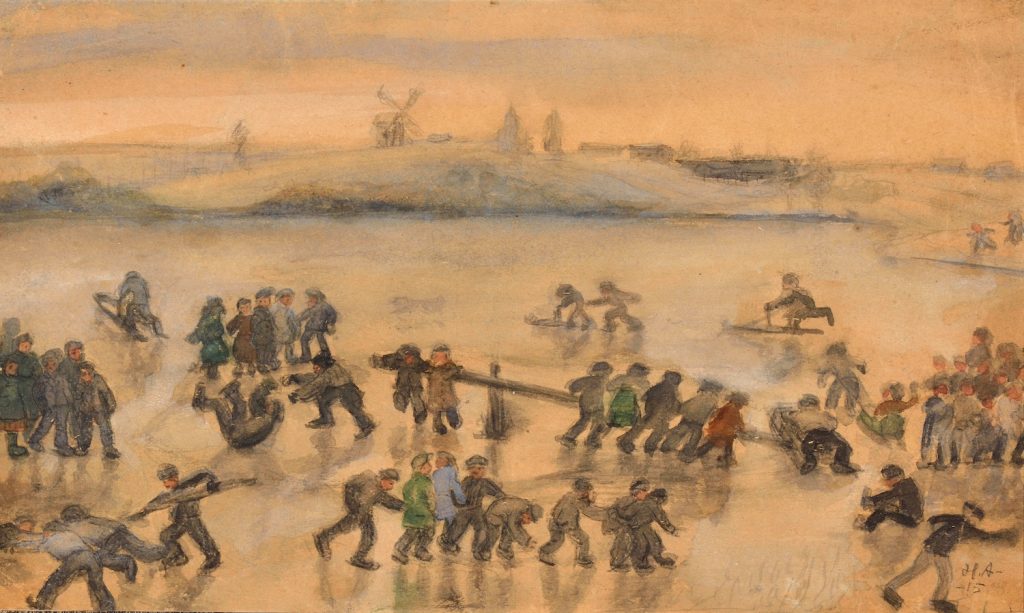Hannes Autere, Merry-Go-Round on the Ice, 1915
November 2021
“I have painted only to please myself, imitating the images born in my own head which have been created out of love for this country and its succulently awkward practises bordering on humour, disregarding any direction or custom, because there seem to be many replicators, as well.”
This is the way Hannes Autere depicted his painted work to Gösta Serlachius in 1932. Two years earlier Serlachius had visited Autere in his Pajupuro home in Saarijärvi and admired the artist’s paintings. Serlachius wanted to buy two of the paintings (Party and Easter Witch) and had inquired about their price in a letter. To his surprise, Autere did not want to sell his paintings. Not at that point, anyway.
The reason for refusal was the painting’s significance for artist himself. Autere was already then renowned for his wood reliefs and miniature sculptures, but he had also created paintings since the beginning of his career. He felt he could express his inner views more deeply and “the dormant juicy qualities of the nation” by painting, as he expressed in his letter to Serlachius in 1930. On the other hand, painting helped him also to learn the skills necessary in sculpting, such as composition, as well.
Painted early on in Autere’s career, watercolour painting Merry-Go-Round on Ice (1915, also known by the names Ice Sleigh and Sleigh-Go-Round) depicts a snowy lakescape. The core of the piece forms a person sitting on a sleigh-go-round and whom the others are together giving a push. A large crowd of people is gathered around the sleigh to enjoy the wintertime amusements. It looks like they are having fun, even though one unlucky person has flown on his back on the slippery ice. In his letter to Gösta Serlachius from 21 November 1932, Autere explains that the picture depicts the recreation of the youth “on autumn ice”. Typical for Autere, the work was inspired by real life. According to the artist, the young people used to gather on the ice on their free time especially on Sundays to have good time.
Often the starting point of Autere’s sculptures and paintings was simple life in the countryside which was familiar to the artist who was born in a peasant family. According to his original style, he depicted humorously and honestly the everyday life, parties and beliefs of the peasants. Autere’s style and brushwork was not suited for concept of painting of his time. This is perhaps why the artist got the courage to show his painting for the first time in public as late as in 1931.
In the joint exhibition with Olga Nordström at Helsinki Art Hall, Autere’s sculptures received commendations, as usual. However, his oil and watercolour paintings got a slightly contradictory reception. Finland’s leading art critics thought the style and the body of paintings on the whole could not reach the level of the sculptures. The originality of the paintings was appreciated, and people felt that the artist’s imagination was expressed more freely in them. The Merry-Go-Round got praised for its beauty and ability to express experientially and observantly the amusement of the young people.
After the exhibition at Helsinki Art Hall, Autere’s painting have been displayed in several exhibitions and they are comprised in art collections around Finland. Also, Gösta Serlachius managed to acquire not two but twenty paintings from Autere. Nowadays the paintings belong to Gösta Serlachius Fine Arts Foundation’s collections and have been added with several others over the years.
Henna-Rosa Laine
Curator
Sources:
Saarikivi, Sakari. Hannes Autere. Suomalaisen puunveiston mestari. Otava, Helsinki 1988.
Kivirinta, Marja-Terttu. Hannes Autere. Göstan pieni taidekirjasto 4. Parvs, Helsinki 2020.
O. O-n. (16.2.1931) ”Hannes Autereen näyttely Taidehallissa”. Uusi Suomi, no. 46.
Heinonen, I. (6.10.1934) ”Tuntematon Autere III”. Keskisuomalainen, no. 230.
Heinonen, I. (1.2.1931) ”Hannes Autere Puunveistäjänä ja taidemaalarina”. Aamu, no 2.
Pänkäläinen, Antti (18.1.1938) ”Hannes Autere – Saarijärveläinen kuvanveistäjä kuuluisuus.” Sisä-Suomi, no. 12.
L. W. (22.2.1931) ”Taidehallin näyttelyt: Hannes Autere, Olga Nordström”. Suomen maa, no 44.


